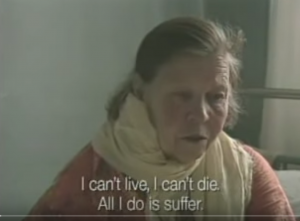Today marks the 30th anniversary of the Chornobyl (Chernobyl) Nuclear Power Plant disaster. On April 25, 1986, workers at the Soviet-era nuclear plant located in northern Ukraine had been preparing for a routine test that had gone terribly wrong. The resulting interaction of very hot fuel with cooling water led to fuel fragmentation, rapid steam production and an increase in pressure that caused the horrific explosions the following day.
Today it’s widely recognized that the Chornobyl disaster was a product of a flawed reactor design coupled with human error by the plant operators. But the fundamental flaw, however, was the very design of the Soviet Union, the totalitarian leaders of which created a state and society founded on a conscious disregard for human life.

Chornobyl was in fact the pinnacle (or nadir!) of a catastrophe that began long before 1986, with equally tragic consequences. Nearly 30 years before Chornobyl, there were a series of nuclear explosions outside the city where I was born, Chelyabinsk, in the Ural Mountains of southwestern Siberia. In the 1950s, this region happened to be the center of the Soviet nuclear weapons industry. And when a catastrophic radiation disaster occurred there, just 40 kilometers from a major population center, the authorities decided to keep the disaster silent. It was a secret, just like the nuclear facility, the entire nuclear weapons industry, and Chelyabinsk itself, a closed city in Soviet times.

Nobody was told anything about the nearby Mayak Nuclear Plant or the Kyshtym Catastrophe, the third largest release of radiation after Fukushima and Chornobyl, and the first of its kind in human history. Workers and villagers at ground zero were evacuated and a fence was placed around the facility. That was it! The rest of the inhabitants in one of the Soviet Union’s major industrial population centers went about their lives the day after the disaster just as they did the day before. Because they knew nothing. They drank the water, played in the lakes, and ate the vegetables from their gardens.
To this day, few people in the West know about Chelyabinsk or its tragic history. I’d like to think that is beginning to change. Longtime NPR correspondent Anne Garrels just came out with a new book about Russia’s heartland, Putin Country, centered in Chelyabinsk in the 1990s. The Guardian‘s Luke Harding also discusses Chelyabinsk’s nuclear legacy in his new book A Very Expensive Poison on the murder of Alexander Litvinenko, who was infamously poisoned in London with rarified polonium, traced back to a nuclear production facility outside Chelyabinsk.
It was only after Chornobyl in the ’80s that the world began to learn about Chelyabinsk in the ’50s. And for those of us who lived there, we began the grim process of understanding the bizarre illness and disease just beginning to manifest themselves. It was only then, nearly 20 years after the fact, that we began to truly understand the moral ailments that underpinned the physical ones. We began to come to terms with the fact that we had lived under a centralized totalitarian government that didn’t even have the decency or conscience to inform its citizens that such a significant event had even occurred. That’s a true tragedy and a catastrophic moral failure.
Accidents happen, but such flagrant disregard for human life witnessed in Chelyabinsk is a symptom of an untenable system.
Thirty years later, the Soviets kept Chornobyl’s problems secret as well, until it all blew up across Ukraine, Belarus, Russia, and Europe. It’s really no accident, then, that just a few years after Chornobyl, the Soviet Union collapsed. Even Gorbachev’s openness reforms, glasnost‘ and perestroika, came too late for a system so deeply morally degraded for so long.
Additional resources to learn more about Chelyabinsk’s nuclear legacy:
- CHELYABINSK: The Most Contaminated Spot on the Planet, Documentary film by Slawomir Grunberg. 1996. Retrieved from http://www.logtv.com/films/chelyabinsk/
- Kyshtym disaster. Wikipedia. Retrieved from https://en.wikipedia.org/wiki/Kyshtym_disaster
- Mayak nuclear plant. Wikipedia. Retrieved from https://en.wikipedia.org/wiki/Mayak
- Chelyabinsk-65. Retrieved from http://www.globalsecurity.org/wmd/world/russia/chelyabinsk-65_nuc.htm
- The Most Contaminated Place on Earth: Chelyabinsk-40 (July 2011). Retrieved from http://sometimes-interesting.com/2011/07/15/the-most-contaminated-place-on-earth-chelyabinsk-40/The Most Contaminated Place on Earth: Chelyabinsk-40
- Alimov, Rashid. Chelyabinsk region residents still being irradiated 50 years on (September 2009). Retrieved from http://bellona.org/news/nuclear-issues/nuclear-russia/2007-09-chelyabinsk-region-residents-still-being-irradiated-50-years-on
- Lake Karachay, Mayak and Chelyabinsk -40: A look at the most contaminated place on earth (October 2012). Retrieved from http://basementgeographer.com/lake-karachay-mayak-and-chelyabinsk-40-a-look-at-the-most-contaminated-place-on-earth/
- Bellows, Allan. In Soviet Russia, lake contaminates you (October 2008). Retrieved from http://www.damninteresting.com/in-soviet-russia-lake-contaminates-you/
- Data Analysis and Physicochemical Modeling of the Radiation Accident in the Southern Urals in 1957. Retrieved from http://fas.org/news/russia/1995/fbust037_95011.htm
- Absolutely Radiant. 1994 Darwin Award Nominee (1994). Retrieved from http://www.darwinawards.com/darwin/darwin1994-25.html
Related:
- Chornobyl destroyed the Soviet Union
- Chornobyl: the secret tragedy which led to the collapse of the Soviet Union
- The Chornobyl Dictionary: Too Hot to Hide
- Ukraine worried about wartime threat to nuclear facilities
- Nebesna Sotnya: Antonyna Dvoryanets, liquidator of Chornobyl disaster
- Kremlin propaganda, fellow travelers, and the third Russo-Ukrainian war




